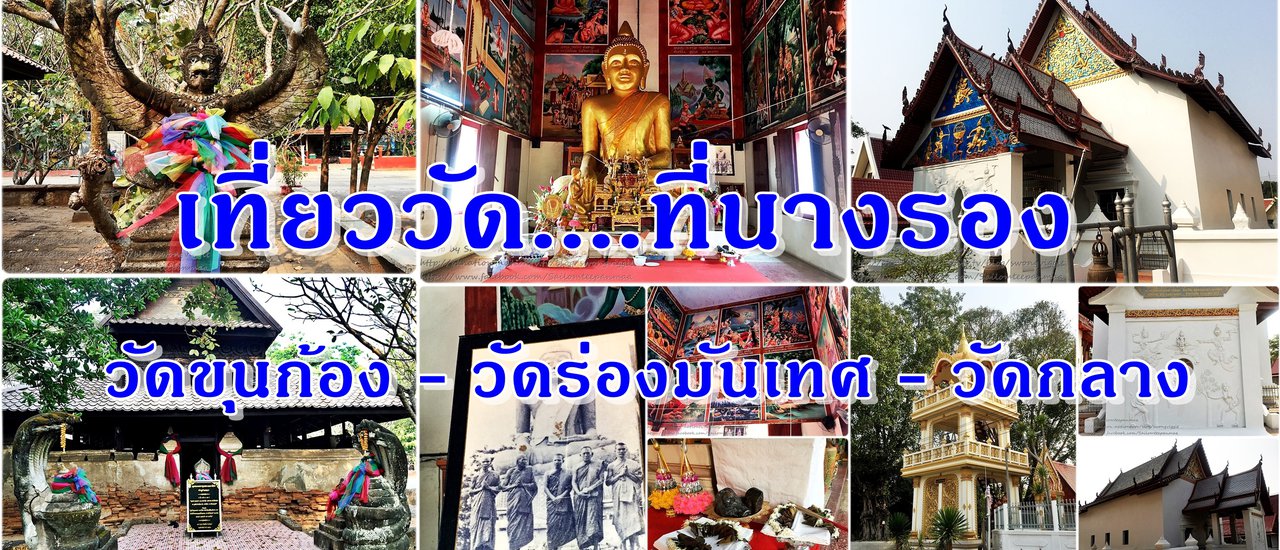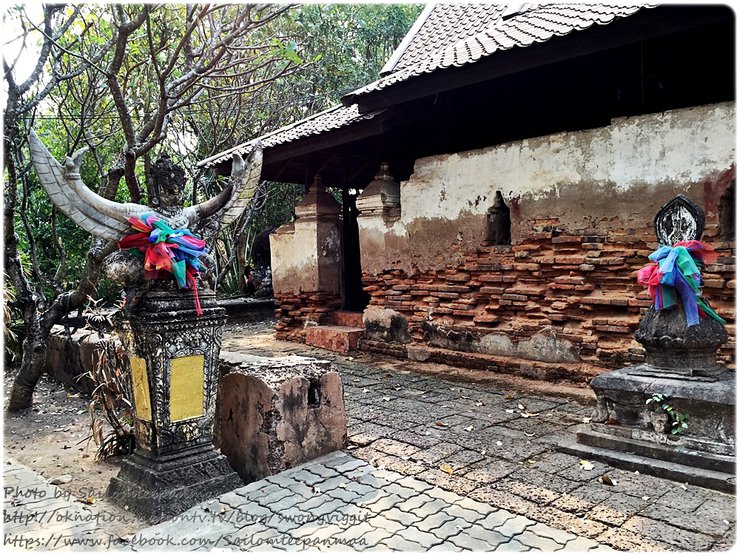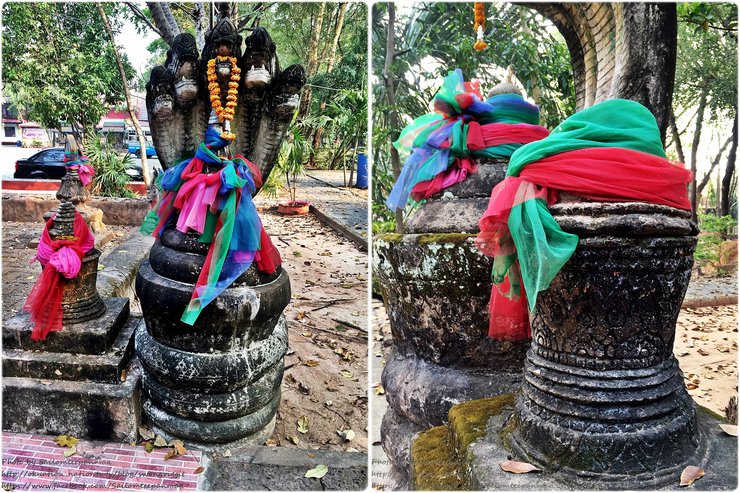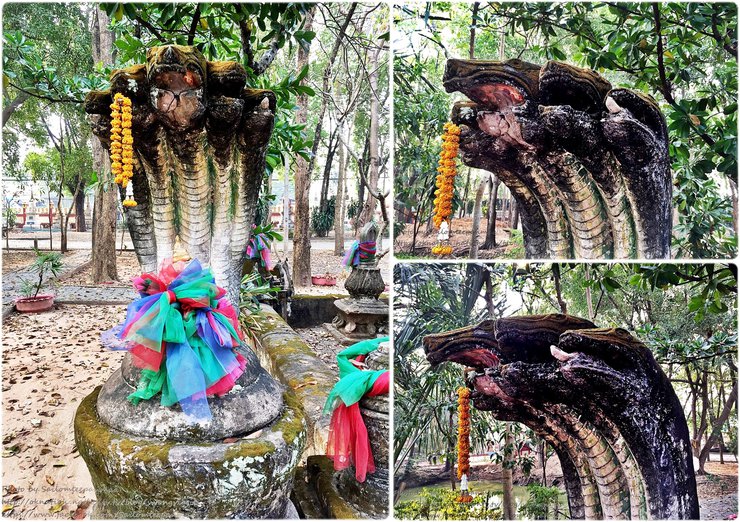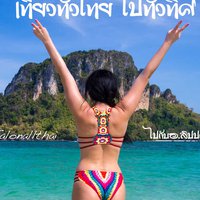
Sim or Ubosot of Wat Khun Kong
The van we had booked was waiting for us at the front of the Panomrungpuri Hotel early in the morning. After breakfast, it was time to continue our journey. As we had to return home that day, we only had time to sightsee in the morning.

Garuda in front of the chapel
Therefore, to avoid wasting time, we chose to visit Nang Rong district. This district alone offers a wealth of opportunities to explore ancient civilizations and ways of life.

The first temple we chose to visit was Wat Khun Kong.

Wat Khun Kong (formerly known as "Khun Kong") is a Buddhist temple and a royal temple, meaning a temple built by the people and not dedicated to the king. It was built during the Ayutthaya period in 1607 AD during the reign of King Naresuan the Great. Khun Kong, a military officer in charge of supplies, built the temple out of devotion and named it "Wat Khun Kong." However, the name later changed to "Wat Khun Kong." The temple features a beautiful ubosot (ordination hall) and kuti (monks' quarters) with impressive architecture.

The Dharma Wheel Stupa and the Crystal Wall
This sentence describes two elements of a Buddhist temple complex: the Dharma Wheel Stupa and the Crystal Wall.
- Dharma Wheel Stupa: This refers to a specific type of Buddhist monument that symbolizes the Buddha's teachings. It is typically a large, white structure with a wheel-like design on top.
- Crystal Wall: This likely refers to a wall surrounding the temple complex, possibly made of glass or another translucent material.
The sentence suggests that these two elements are significant features of the temple, perhaps due to their religious or architectural importance.

Five-headed nagas guard the two sides of the entrance, each side with a different naga.
The Temple of Khun Grong: A Historical Legacy
This passage describes the origin and history of Wat Khun Grong, a temple in Thailand.
Key Points:
- Founder: Khun Grong, a military officer who oversaw provisions for King Naresuan and King Ekathotsarot during their campaign against the Khmer.
- Original Name: Wat Khun Grong, later corrupted to Wat Khun Kong.
- Construction: Pre-dates the Buddhist Sangha Act of 1878, making it over 405 years old.
This temple was built by "Khun Grong," a military officer who oversaw provisions for King Naresuan the Great and King Ekathotsarot. At the time, they had not yet ascended to the throne and were leading an army to subdue the Khmer. They set up camp in Nang Rong, where Khun Grong built the temple. It was originally called "Wat Khun Grong," but over time, the name was corrupted to "Wat Khun Kong."
The temple predates the Buddhist Sangha Act of 1878, making it over 405 years old.
Note: The translation maintains a formal academic style, avoids personal pronouns and colloquialisms, and supports claims with evidence. It also uses the active voice and is concise.

This side depicts a naga with a monkey head and some with protruding tongues.

The highlight: The molding of the figures of soldiers standing guard in front of the temple gate, instead of the giants of Wat Jaeng or Wat Pho, is due to the fact that the old ordination hall received the royal grant of Wisung Kham Sima in 1717. A wall was built around the ordination hall, 1.50 meters high. At the gate of the ordination hall wall on the south side, two soldiers were molded, called "Chao Khun Sai-Khwa". They are ancient soldiers standing facing each other, as if they were guarding the city from enemy invaders, as the area around the temple was surrounded by a moat.


The walls of the church, which have deteriorated over time.
The temple's serene atmosphere makes it an ideal place for meditation. Although the ancient ordination hall is no longer in use, it remains open to the public for educational purposes, allowing visitors to learn about the history of the local community.

The image depicts two military officers standing guard at the entrance of a temple. These figures are known as "Chao Khun Sai-Khwa."

The presence of a sema, a boundary marker indicating sacred space, suggests that this is a sim (a term for a Buddhist ordination hall in the Isan region of Thailand).

The pavilion at the corner of the glass wall of the ordination hall

The naga on the other side of the entrance has a crest and a dewlap.

Old Ubosot of Wat Khun Kong


Ornate fretwork on the roof of the chapel



Apart from the old church, there are many other interesting things in Wat Khun Kong, such as the statues of various monks and the large and beautiful pond behind the temple. However, due to our limited time, we had to leave Wat Khun Kong for now and head to Wat Rong Man Thet.

The pond behind Wat Khun Kong

The next temple we visited was Wat Rong Man Thet, an ancient temple in Nang Rong District, Buriram Province (located next to Nang Rong Morning Fresh Market). Looking back at its history, in 1895, after Khun Luang Pha Ngua, who later ascended to the throne as King of Thailand, Rama III of Ayutthaya, triumphed over the rebellious Khmer and expanded the Thai territory, driving the Khmer out of various regions in southern Isan.

Temple of the Sweet Potato Ditch
The establishment of Nang Rong town marked its inception within the boundaries of the Kingdom of Thailand. The town's founding was accompanied by the construction of a temple, "Wat Aram Samakkee," later known as "Wat Rong Man Thet." However, the construction remained incomplete as the king led his troops back to Ayutthaya due to the imminent threat posed by the Mon army approaching from the west.


The Sacred Buddha Image, the Guardian of Nang Rong City
The people of Nang Rong have continued to build, maintain, and preserve the temple. Although it has been neglected and abandoned at times, perhaps due to political reasons, it is now a complete temple with various religious buildings and a center for Buddhists in the area. It is also a source of pride and remembrance of the great kindness of King Phuangua, the founder of the city, who remains in the hearts of the people of Nang Rong forever. The temple also houses the sacred principal Buddha image of Nang Rong.

This principal Buddha image predates the construction of the chapel. Therefore, the chapel was built around the existing image.

The old evidence shows that the principal Buddha image existed before the construction of the chapel.

Ubosot of Rong Man Thet Temple

The area surrounding the Ubosot of Rong Man Thet Temple

Not far from Wat Rong Man Thet, there is another interesting temple called Wat Klang. This temple is located in the middle of the market. Unfortunately, the interior of the ubosot is closed to the public. However, visitors can still admire the beautiful wooden doors and windows with intricate carvings, as well as other architectural features, such as the tall bell tower next to the ubosot. Inside the bell tower, there are murals depicting dancing angels bestowing blessings.

Central Temple Chapel
Another interesting feature of Wat Klang is the white wiharn with a floating wall decorated with bas-reliefs of Rama and Hanuman on the top and Narasimha and Narasimha with the Makhanari fruit on the bottom.

The closed ordination hall of Wat Klang and the carved wooden doors and windows.

As the ordination hall of Wat Klang was closed, we had a little extra time on our hands. This reminded us of another interesting place, "Phu Man Fa". So, we decided to head there.
Related topics:
Review...Nang Rong Budget & Boutique Hotel (Nang Rong Hotel)
Temple of Unknown Origin... Prasat Muang Tam
The "Prasat Muang Tam" musical, a legend of the "Prasat Muang Tam" musical, will be held at the "Withee Chumchon Buriram" market.
Wana Rung (Phanom Rung) Vilai ...... The Divine Palace of Mount Kailash
Local Identity Fabric.....Mud-dyed Cotton from Volcano "Phu Akane Fabric"
Worship the Ashes of the Fire God on the Volcano's Peak: Witness the Thousand-Year-Old Stelae at "Wat Khao Phra Angkhan," Buriram
A small school in the vast field… The joy in the vast field with Kru Li at Ban Thawan, Buriram.
"Market" is crowded ..... Nang Rong Baan Aeng, Buriram
Review of Phanomrung Puri Hotel
This sentence provides a link to a review of the Phanomrung Puri Hotel.
Visiting Temples in Nang Rong, Buriram: Wat Khun Kong - Wat Rong Man Thet - Wat Klang
This sentence describes a visit to three temples in Nang Rong, Buriram: Wat Khun Kong, Wat Rong Man Thet, and Wat Klang. The links provided offer further information about these temples.
Buddhist Sila Monastery "Phu Man Fa", Chamni District, Buriram Province
สายลม ที่ผ่านมา
Monday, November 11, 2024 10:32 AM

